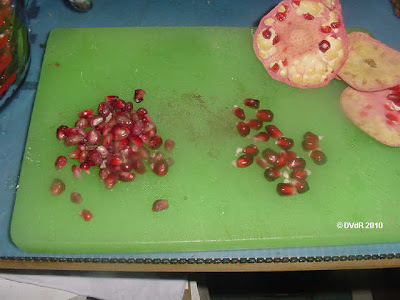When I was about 14, someone gave me a pomegranate. I thought it was very tasty, but FAR too much work for what I got from it. Now (and better late than never) thanks to the internet, I found out it is unbelievably easy to get the tasty juice pods (called arils) from the fruit.
Due to what must be an enormous advertising budget, most of us have POM Wonderful's pomegranate juice in our grocery stores.
I have even bought some of their juice for the superb antioxident properties, but I always have a niggly feeling at the back of my neck because it is a processed product. (Wonderful, by the way, is the name of a pomegranate cultivar originating in Florida and first propagated in California in 1896. it is the leading commercial pomegranate in California, and better for juice rather than eating fresh.)
 |
| Antioxident graph from POM Wonderful's website |
I have even bought some of their juice for the superb antioxident properties, but I always have a niggly feeling at the back of my neck because it is a processed product. (Wonderful, by the way, is the name of a pomegranate cultivar originating in Florida and first propagated in California in 1896. it is the leading commercial pomegranate in California, and better for juice rather than eating fresh.)
My favorite almost-local grocery store had a huge bin of fresh pomegranates outside the front door recently, 3/$5. I guess that might be a good price considering they are usually shipped in from California or else imported... my in-town store had some at 2/$5 and they were quite a bit smaller. (Buying them goes against my food politics for eating local, but so does my coffee.) So, I bought some, mainly because I had just seen the video on how easy it is to seed them.
I had planned to include pomegranate in some dish for Thanksgiving, but then the oven died and I got caught up trying to bake in my small tabletop oven... with many failures before some small successes. Finally I had time today to fetch my 3 pomegranates from the root cellar, and seed them. Actuallym they will keep for months in a root celler, but I want to use them soon. For now, I shall freeze them scattered on jelly-roll pans so they don't stick together. Recipes will follow later when I make something from them!
The video (below) is pretty explicit, but I'd like to add a few notes from my experience. Yes, they do bleed. It stains! I cut the top off the first one too deeply, cutting some of the arils and losing their juice, leaving only seeds. I also scored the skin too deeply on the first one. For the next two poms, I scored the skin in 6 sections rather than 4 like the video, and found them much easier to handle. (The photo above is the second one I cut, and that amount cut off the top and bottom worked the best.)
I also didn't start with enough water in my bowl, as you can see above. When I increased the amount of water, it was much easier to gently rub the arils loose without damaging them. More water helps the membranes float free more easily, too. (I just used a skimmer to scoop the membranes off.)
There were a few immature arils in the first one I cut. You can see them at the left in the photo above, but not very well. They were sort of a yellow-gray color, and soft and squishy. I also had a few arils where the pith stuck to the tip, and I set them aside as I was sorting (on the right in the photo above). All it took was a flick of a fingernail to remove that bit and add them to the bowl.
I ended up with about 5 cups of arils, and a huge pile of peel and membrane! There are many recipes for pomegranates inline. POM wonderful has a few that intrigue me, here. I also found a few recipes here. Their pomegranate sorbet and pomegranate flan both sound yummy.




Interesting. Seeing that chart of relative antioxidant levels sends me in search of info on whether or not concord grapes will grow up here... better an antioxidant on the land than one in the store. LOL
ReplyDeleteA great way to have some pomegranate seeds on hand for recipes, too. Thanks!
You are right about antioxidents home-grown. I always wonder how many are killed in processing.
ReplyDeleteSorry the chart runs too wide, but if I reduce it, no one will be able to read the text under the glasses.
Don't know how heat stable antioxidants are, but if it's easier, cheaper & more available, I figure I'll end up eating more of whatever & thereby take in more.
ReplyDeleteI suppose one could to a low heat pasteurization (like for milk) & freeze the juice... I just don't like to rely on electricity or fill up my freezer w/liquid. But that's just me. =0)
Or one could figure out how to make wine... LOL Apparently it is possible to actually give concord grapes a dry finish, rather than the sickly sweet one so commonly known.
I don't like relying on a freezer at all, fearing long power outages...but I use it anyway.
ReplyDeleteI'm trying to make wine, first time since 30 years ago, forgot everything I once knew! Mine are fruits, not grapes, although I do have a no-name local grape vine that covers one shed.